
Ho Chi Minh City, known for its vibrant blend of cultures, is a bustling metropolis that never sleeps, offering exciting entertainment day and night.
Located in the subequatorial monsoon tropical region, Ho Chi Minh City experiences high temperatures year-round, with distinct rainy and dry seasons. The rainy season lasts from May to November, while the dry season spans December to April. The average temperature hovers around 27 degrees Celsius, with occasional highs surpassing 40 degrees Celsius. Despite the heat, the city's abundant sunshine is not too intense, humidity remains relatively low, and evenings tend to be pleasantly cool.
The mild weather in Ho Chi Minh City makes it a suitable destination throughout the year. If you visit during the rainy season, it's advisable to carry an umbrella to be prepared in case of sudden showers.
Ho Chi Minh City offers diverse tourism products across its various districts. The city boasts a wide array of entertainment activities, amusement parks, sightseeing spots, and shopping destinations that cater to different preferences.
Exploring Ho Chi Minh City by river bus
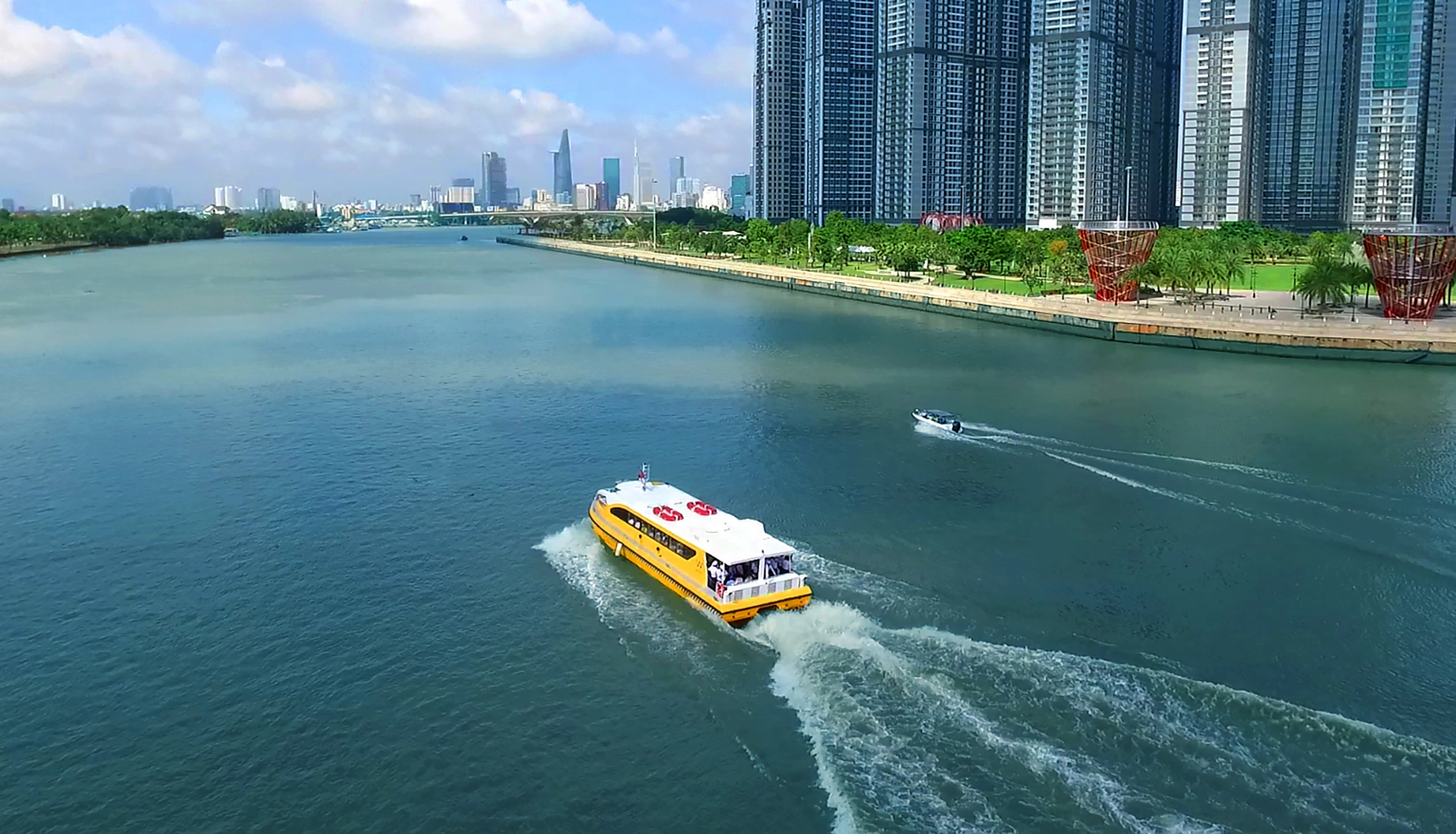
One unique experience in Ho Chi Minh City is taking a river bus, which allows visitors to see the city from a different perspective and pass by famous landmarks such as Nha Rong Wharf, Ben Nghe Port, Phu My Bridge, Saigon Peninsula, and Binh Khanh Ferry Terminal.
The river buses operate daily from 8:30 a.m., departing from Bach Dang, Binh An, Linh Dong, Thanh Da, and Hiep Binh Chanh wharfs on the Saigon River. There is also a night bus route that departs no later than 10 p.m. Tickets can be purchased online or directly at the wharf for VND15,000 (64 cents) per ride.
Enjoy a dinner cruise
Visitors can embark on a dinner cruise that sets sail from Saigon Port. These cruises take guests along the Saigon River, offering breathtaking views of Nha Rong Wharf, Ben Nghe Port, Saigon Bridge, and the Landmark 81, Vietnam's tallest building. Guests can enjoy a dining experience while immersing themselves in the beautiful scenery. Ticket prices for the cruise range from VND350,000 to over VND1 million ($14.90 to $42.58) , depending on the type of cruise. Dining options include Asian-European style buffets, or combo meals. The cruises often feature musical performances and magic shows.
Furthermore, travelers have the option to rent a compact yacht that can accommodate approxiamtely 20 people, with prices ranging from VND10 million to VND25 million ($425.76 to $1,064.39).
Sightseeing from a double-decker bus
In the city center, there is an open-top double-decker bus that provides a unique way to sightsee. The bus is equipped with a multi-language voiceover system that automatically guides passengers to famous attractions along the route. It offers tourist maps, free Wi-Fi, and guides onboard. Each trip takes about 60 minutes and passes by popular places such as the Saigon Zoo and Botanical Garden, the War Remnants Museum, Bui Vien Walking Street, Ben Thanh Market, Nguyen Hue Walking Street, and the Saigon Opera House. The tour concludes with a visit to Saigon Skydeck on the 49th floor of Bitexco Financial Tower, offering a bird's-eye view of the city.
The bus operates from 9 a.m. to 10 p.m. daily with trips departing every 30 minutes. In the evening, the bus also provides a dinner service package on a luxury cruise along the Saigon River. Tickets can be purchased at a counter at the tour’s starting point on Nguyen Hue Street in District 1. Seats can also be booked online.
Stroll the parks
Folks can take a leisurely walk at the Saigon Zoo and Botanical Garden. Rich with over 150 years of history, this is the 8th oldest zoo in the world. Originally a botanical garden, it now houses more than 1,000 animals, a diverse range of more than 2,000 trees from 260 species, 23 varieties of domestic orchids, and 33 different species of cacti. This site provides a green sanctuary for the city's residents to enjoy and serves as a valuable research hub for scientists. The fresh environment is perfect for a peaceful break.
Ho Chi Minh City also has other beautiful parks and green spaces, including Tao Dan Park, Hoang Van Thu Park, Le Van Tam Park, and Gia Dinh Park, where visitors can enjoy nature and serenity.
Live music experiences
In the evenings, sipping coffee or enjoying a glass of wine while listening to live music is a fun activity in Ho Chi Minh City. There are numerous venues that offer live music performances, catering to different musical tastes, from vibrant rock to jazz and acoustic performances. Some recommended spots for the night owl include Ben Thanh Tea Room, We, No Name, Dong Dao, Yoko Cafe, Rock Fan Club, Acoustic Bar, Drinking & Healing, and Vung.
Fun in the "Western Ward"
The streets of Bui Vien, De Tham, and Pham Ngu Lao in District 1, commonly referred to as the "Western Ward," burst with energy from evening till the early hours of the morning. These bustling streets offer free public facilities such as toilets, Wi-Fi connections, and a tourist information station. This area is particularly popular among young people and tourists, especially Westerners. The street is lined with hundreds of cafes, bars, pubs, and food stalls, creating a lively atmosphere. It is also home to various tour kiosks.
Discover Chinatown's life and cuisine
Chinatown encompasses parts of districts 5, 6, and 11, with District 5 being the busiest and most well-known. Walking along streets like Tran Hung Dao, Chau Van Liem, and Luong Nhu Hoc, visitors can admire old Chinese shophouses that date back around 100 years. There are also numerous historic temples, society buildings, and Chinese restaurants. Exploring Chinatown is an opportunity to savor delicious dishes such as roasted duck, fried rice, curried fish balls, hand pulled noodles, chicken soup with herbs, and dim sum.
Luong Nhu Hoc Lantern Street is a must-visit during the Mid-Autumn Festival, especially in the evening when colorful lanterns adorn the street, creating a glow of shimmering beauty. Oriental medicine streets – including Hai Thuong Lan Ong, Trieu Quang Phuc, and Luong Nhu Hoc in District 5 – are other notable hubs of traditional CHinese culture. Here, Chinese merchants have been trading medicinal herbs for centuries, resulting in a vibrant neighborhood dedicated to natural remedies.
Ho Chi Minh City is also made dynamic by its sites of great cultural and historical significance. The city is home to numerous monuments and museums that are well-known to both local and international tourists.
Independence Palace
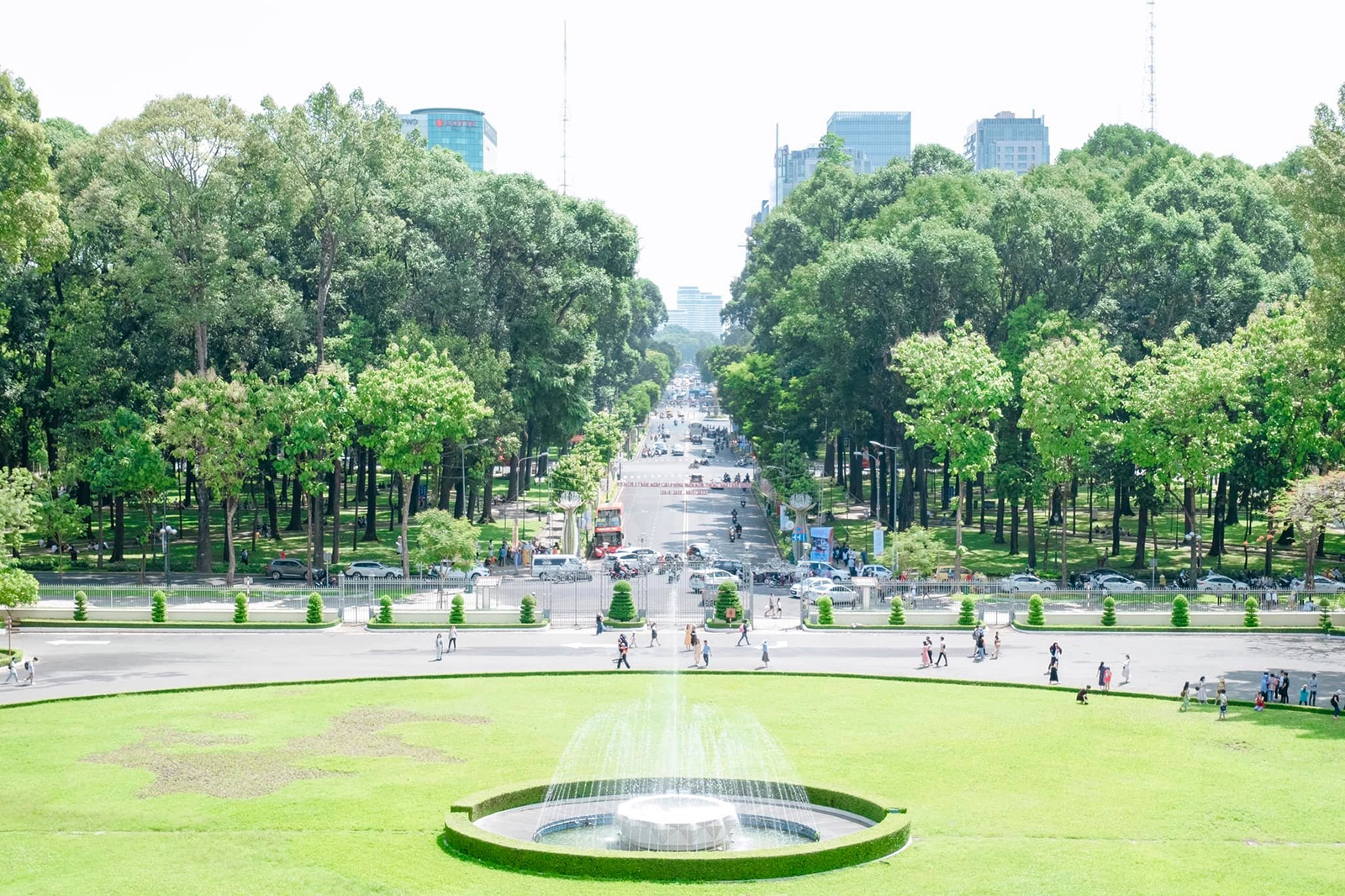
The front garden of the Independence Palace is abundant in lush green. Photo by Henry Duong
The Independence Palace, also known as the Reunification Palace, in the heart of District 1, seamlessly blends the old and the modern, symbolizing the city's rich heritage. On weekends and major holidays like the Reunification Day April 30, the palace attracts many visitors.
Tickets to visit the main building and the gallery "From Norodom Palace to Independence Palace 1868 - 1966" range from VND15,000 to VND65,000 (64 cents to $2.77). If you prefer to explore only the main building, tickets cost between VND10,000 and VND40,000 (43 cents to $1.70).
War Remnants Museum
The War Remnants Museum, listed as the 61st most attractive destination in the world, is a significant representation of Vietnam's history. The museum, situated at 28 Vo Van Tan Street in District 3, was founded in 1975. It is dedicated to researching, collecting, preserving, and showcasing evidence of the crimes and consequences of the wars in Vietnam. With over 20,000 documents, artifacts, and films, the museum covers various topics, including a vast array of military equipment on display in an outdoor exhibition. Other exhibitions include "The World Supports Vietnam in its Resistance," "Victims of Agent Orange Overcome Difficulties," "Historical Truth," and "Aggressive War Crimes."
Admission to the museum is priced at VND40,000 ($1.70) per person, while children under 6 years old can enter for free. The museum is open from Monday to Friday, from 7:30 a.m. to 11:30 a.m., and on Saturdays and Sundays from 7:30 a.m. to 4:30 p.m.
Saigon Special Forces Museum
The Saigon Ranger Museum is on the second floor of a house built in 1963 at 145 Tran Quang Khai Street in District 1. This house served as a secret operating base for the Saigon Special Forces, a resistance unit led by Tran Van Lai (also known as Nam Lai). The museum, which has been operating since December 24, 2019, covers an area of over 100 square meters and showcases more than 100 artifacts related to these special soldiers. The objects in the house are preserved in their original state, providing visitors with an authentic experience. Short films about the Saigon Special Forces are also available for viewing.
The museum is open from 7 a.m. to 10 p.m. on weekdays, and admission is free.
The Ho Chi Minh City History Museum
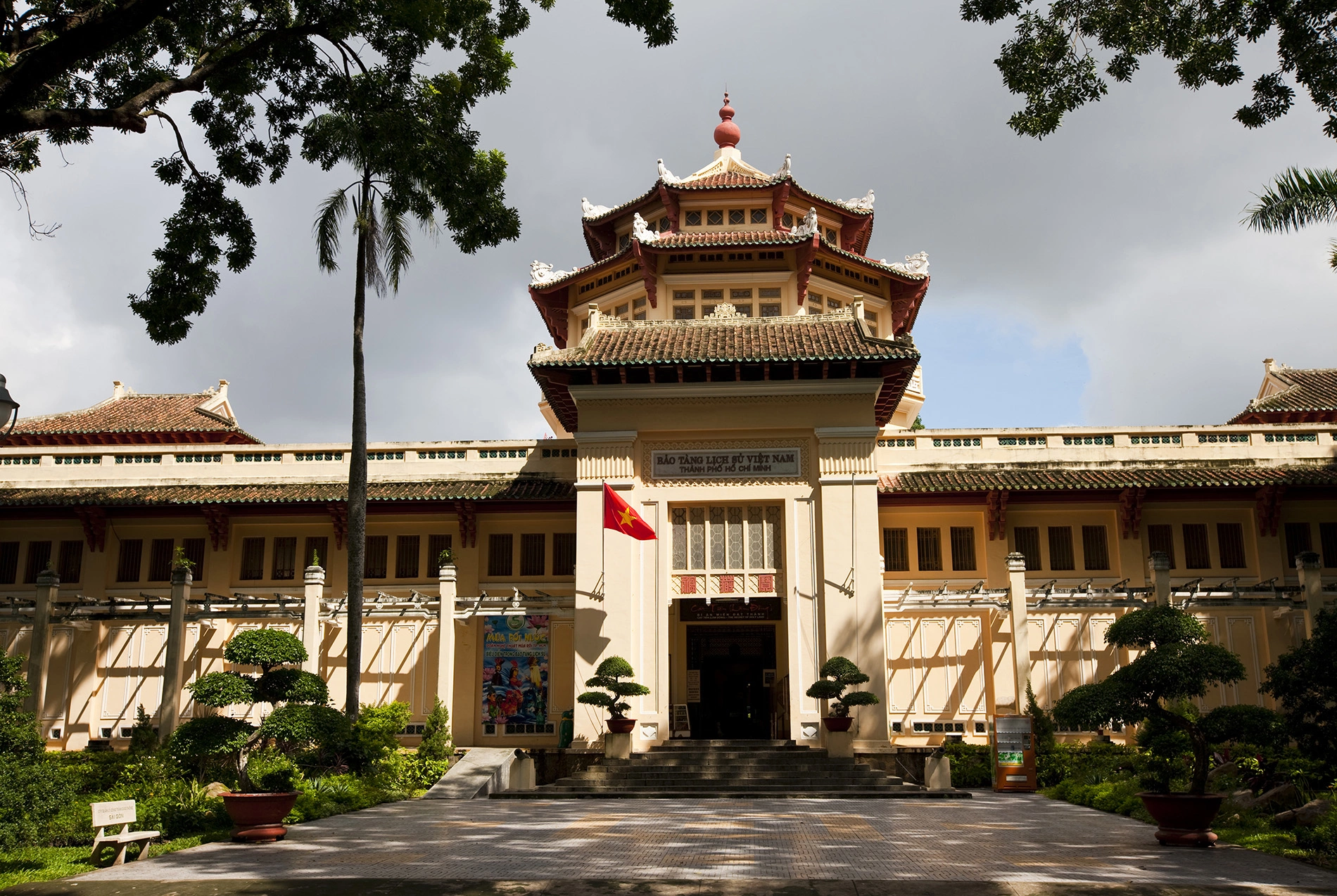
Situated at 2 Nguyen Binh Khiem Street in District 1, the Ho Chi Minh City History Museum was designed by architect Auguste Delaval and built in 1929. It features wide European corridors for ample natural light, and a roof design that minimizes the impact of the region's hot and humid climate. The centerpiece is an octagonal tower adorned with gold paint and captivating Asian-style decorations. The museum showcases approximately 36,000 artifacts that reflect the history of the Vietnamese nation from ancient times to 1945. Additionally, it showcases other ancient civilizations in Vietnam, including Oc Eo, Champa, and Khmer.
Visiting hours are from 8:30 a.m. to 11:30 a.m. and from 1 p.m. to 5 p.m. The entrance fee is VND30,000 ($1.28) per person.
Ho Chi Minh City Museum of Fine Arts
The Ho Chi Minh City Museum of Fine Arts is at 97A Pho Duc Chinh Street in District 1. This building was formerly the residence of Hua Bon Hoa's family, one of the richest men in Saigon during the late 19th century. The museum attracts art and photography enthusiasts alike.

The building showcases a blend of French architectural styles from the late 19th and early 20th centuries, with oriental influences seen in decorative tile roofs and ceramic columns. Visiting hours are from 8 a.m. to 5 p.m. on weekdays.
Cu Chi Tunnels
Located approximately 70 kilometers from the heart of Ho Chi Minh City, Cu Chi Tunnels in Cu Chi District boast an extensive tunnel system spanning around 250 kilometers. Once serving as a stronghold for the base of the Party Committee of the Saigon - Gia Dinh Military Region, these tunnels played a pivotal role in the reunification of Vietnam. Today, visitors can explore the preserved remnants of the tunnels in two areas: Ben Duoc in Phu My Hung Commune and Ben Dinh in Nhuan Duc Commune, both of which offer immersive experiences. Some sections of the tunnels have been renovated and widened for easier access.
To reach the Cu Chi Tunnels, you can take bus number 13 directly from Ben Thanh Market or opt for a taxi ride, which typically costs around VND500,000 ($21.29) one way. If traveling by private car or motorbike, follow Highway 22 and then turn onto Provincial Highway 15.
Can Gio

Situated approximately 50 kilometers from the city center, this coastal suburban district is both a natural and historical site, offering a captivating blend of forests, mountains, and sea. Spanning an area equivalent to Singapore, this destination has lots of ecotourism activities that can be experienced during the day. As the sole district in Ho Chi Minh City bordering the ocean, Can Gio holds the distinction of being Vietnam's first mangrove forest recognized as a global biosphere reserve by UNESCO in 2000.
Visitors can explore the Can Gio Mangrove Biosphere Reserve, where they can glide through the mangrove forest on a canoe and visit the Sac Forest Special Zone. Sac Forest used to be a military base for officers and soldiers of the Sac Forest Commando Unit 10 during the resistance war against the U.S.
Embark on a memorable adventure as you observe Can Gio’s community of over 1,000 monkeys. You can cruise the river to reach the Vam Sat Ecotourism Area, where you can row a boat and explore a bat reserve. Delight in the thrill of crab fishing, pay a visit to the vibrant bird sanctuary, and be captivated by the presence of the lilac crocodile. For an adrenaline-pumping experience, you can conquer the 26-meter high Tang Bong tower for stunning panoramic views of the mangrove forest.
Food enthusiasts will delight in Can Gio's Hang Duong market. Here, seafood lovers will find an abundant selection of shrimp, crabs, snails, and squid at affordable prices. Take your pick of the freshest catch and enjoy the convenience of having it prepared on the spot by the vendors.
To reach Can Gio, head towards Tan Thuan Bridge from the city center and proceed to Binh Khanh Ferry to purchase a ferry ticket. Travelers have the option of reaching Can Gio by motorbike, car, or bus.
Saigon Central Post Office
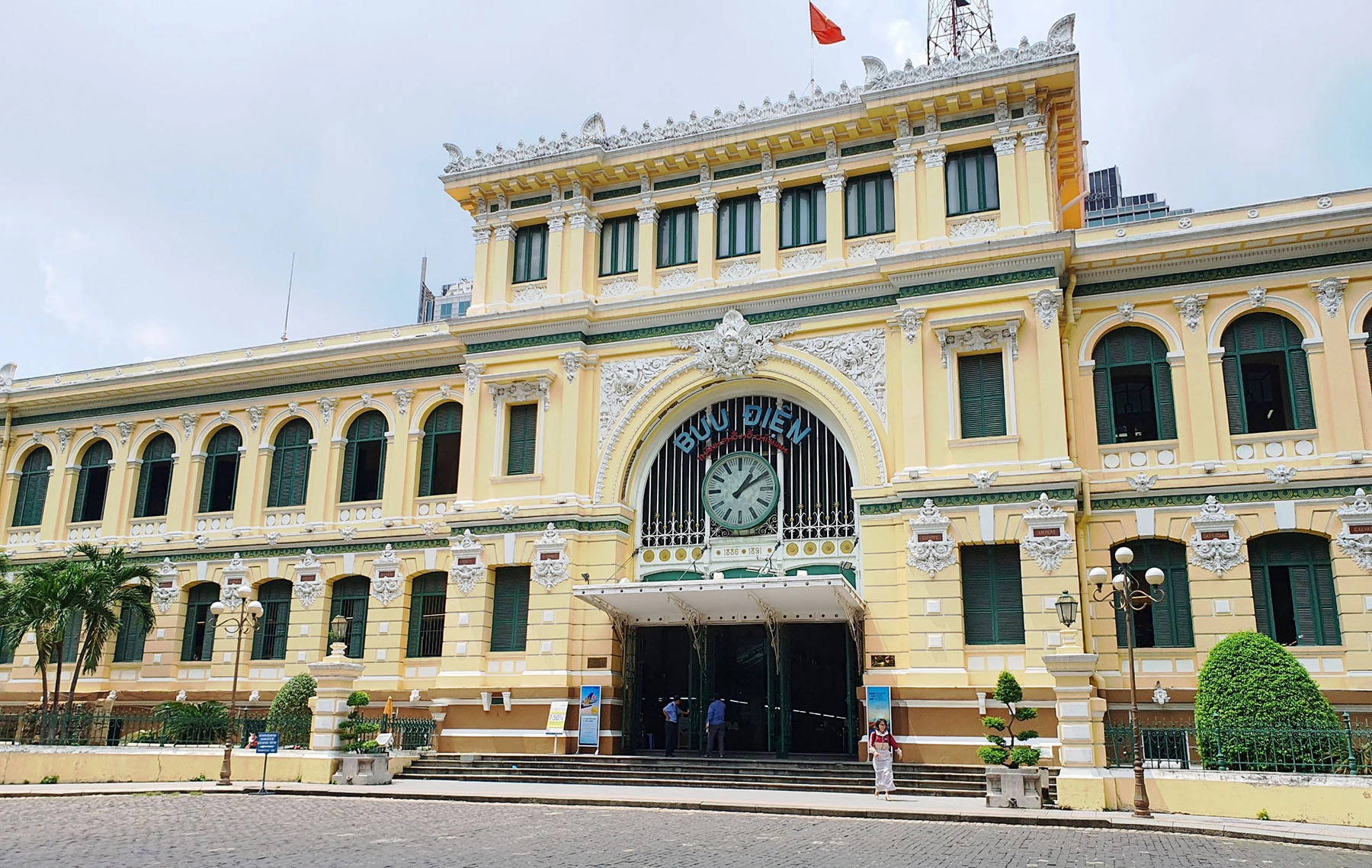
A glimpse of Saigon Central Post Office, an iconic building in District 1, HCMC. Photo courtesy of Ho Chi Minh City Department of Tourism
The Saigon Central Post Office, located at Paris Commune Square, District 1, was constructed between 1886 and 1891 by French architects Alfred Foulhoux and Henri Auguste Vildieu. This is the largest post office in Vietnam, and has retained its original design over the years. Its notable features include an arched ceiling with a portrait of Mercury, the god of transformation and communication, surrounded by a laurel wreath. The architectural style of the post office resembles that of the Gare d'Orsay, a renowned train station-turned-museum in Paris. The post office adds to the city's distinctive architectural ensemble alongside Notre Dame Cathedral.
Operating hours: Monday to Friday, 7 a.m - 7 p.m.; Saturday, 7 a.m - 6 p.m.; Sunday, 8 a.m. - 6 p.m.
Saigon Opera House
Located at No. 7 Lam Son Square in District 1, the Saigon Opera House stands right at the heart of the center of the city. Designed by architect Eugène Feret and opened in 1900, this venue is a locus for the city's vibrant arts scene. Drawing inspiration from the architecture of the Petit Palais, a renowned museum and art gallery located in the middle of Paris, the Saigon Opera House is the only building in the city adorned with Ardoise tiles. Ardoise are known for their durability, weather resistance, and elegant appearance.
Visiting hours: Monday to Friday, 9 a.m. to 4:30 p.m.; Saturday and Sunday, 9 a.m. to noon.
Saigon Notre Dame Cathedral

Saigon Notre Dame Cathedral is one of the city’s most prominent symbols. Located in central District 1, this church was designed by French architect J. Bourad in a blend of Roman and Gothic styles. Construction began in 1877 and was completed in 1880. The interior features a main nave, two side aisles and two chapels that can accommodate up to 1,200 parishioners. The cathedral is surrounded by a lovely little park.
Visiting hours: 8 a.m to 11 a.m. and 1 p.m. to 4 p.m. Please note that the cathedral is currently under renovation, with an expected completion date of 2027.
Ben Thanh Market

Tan Dinh Market
Established in 1926, Tan Dinh Market features a unique architectural design at its main entrance. Alongside its wide array of goods, this market is renowned for its cuisine. Visitors can savor a variety of dishes, including noodle soups, fruit platters, and the market’s famous chicken sticky rice.
Binh Tay Market (Cho Lon)

Binh Tay Market from the outsid. Photo by courtesy of Ho Chi Minh City Department of Tourism
Binh Tay Market, located in Chinatown at the western gateway of the city, holds a special place in the hearts of many tourists. Built in 1930, this market showcases captivating Asian-style architecture, featuring curved roof corners reminiscent of pagodas and temples. The market's bustling atmosphere and diverse offerings make it a must-visit destination.
Ho Chi Minh City is where diverse cuisine from various regions and countries converge. From traditional Vietnamese dishes like broken rice and noodles, to flavors from China, India, Japan, Korea, Thailand, and even vegetarian options, the city offers a wide array of culinary experiences. Must-try dishes include grilled broken rice, banh mi (Vietnamese sandwich), hu tieu (pork and seafood noodle soup), snakehead fish, banh xeo (sizzling pancakes), and com chay kho quet (crispy rice and caramelized fish sauce).
Phan Xich Long Street
Located in Phu Nhuan District, this street is home to renowned restaurants, eateries, and culinary brands. From hot pots and barbecues to European, Japanese, Korean, and Vietnamese cuisine, visitors can explore a wide range of dining options. The surrounding streets named after flowers – such as Hoa Phuong (phoenix flower), Hoa Lan (orchid), Hoa Hue (lily), and Hoa Mai (yellow mai) – also host cafes and rooftop bars that stay open until midnight.
Vinh Khanh Street
Snail dishes are a specialty in Ho Chi Minh City, and Vinh Khanh Street in District 4 is a hub for famous snail and seafood restaurants. Open until midnight, these establishments offer a variety of snail preparations. There’s the salted egg sauce variety, stir-fried tamarind specialties, snails simply grilled with salt and pepper, or snails fried with sacha sauce.
Ho Thi Ky Street
Located in District 10, this food street attracts both tourists and locals with its diverse dishes and specialties from different regions of Vietnam. Grilled skewers, grilled lobster with cheese, and grilled squid with salt and chili are among the most popular options available at over 100 shops. Prices range from VND7,000 to VND100,000 (30 cents to $4.26).
Nguyen Thuong Hien Street
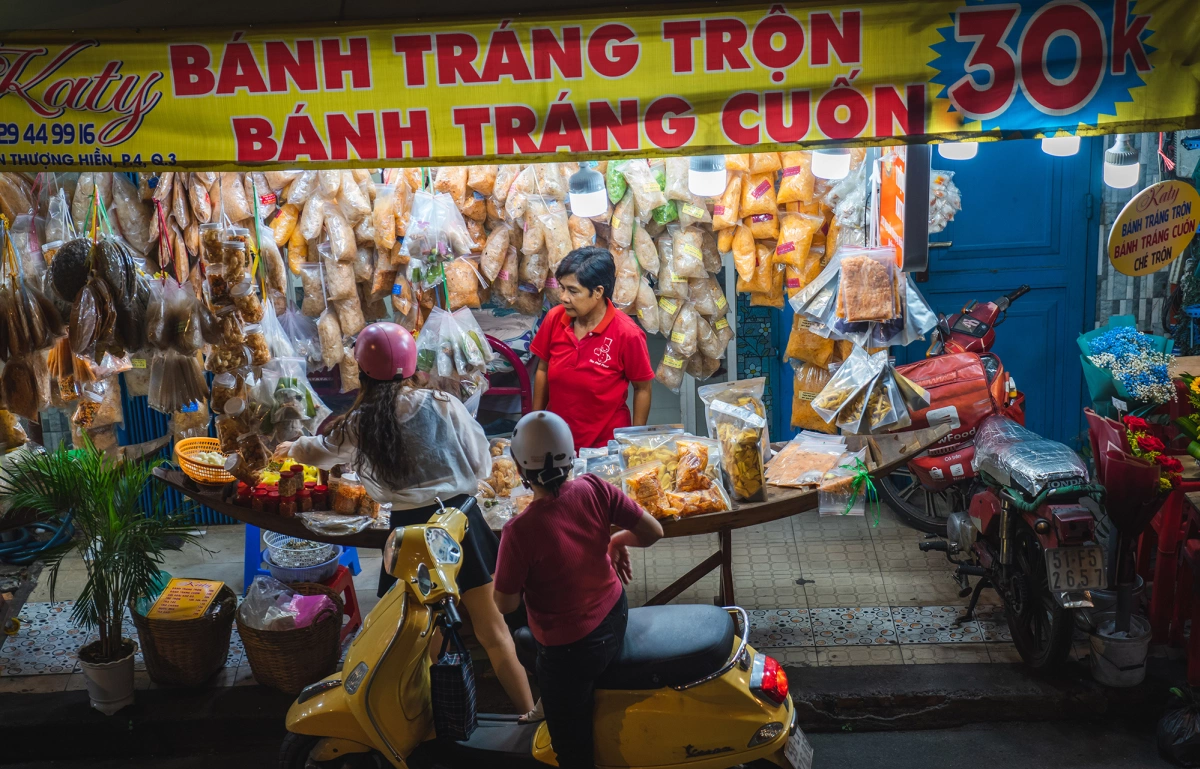
Visitors can find all kinds of snacks in Nguyen Thuong Hien Food Street. Photo by VnExpress/Le Tin
Operating from 7 p.m. to 11 p.m. daily, Nguyen Thuong Hien Street in District 3 entices visitors with more than 90 food and beverage outlets. Feast on banh trang tron (rice paper salad) or tre tron (a salad mixture of fermented shredded pork meat, kumquat juice, beef and garlic), wash it down with refreshing grapefruit juice, or explore Cambodian-style cuisine at select shops. The street also features over 50 shops selling clothing, shoes, and beauty products.
Ha Ton Quyen Street
Located in District 11, this street is renowned for its Chinese-style dumplings. With shops on both sides of the avenue, the neighborhood is bustling all day long, serving an array of dumpling variations, from fried and dried (with oyster sauce), to dumplings swimming in noodle soup topped with shrimp, squid, mixed fillings, and fish balls. Average prices per portion range around VND50,000 ($2.13).
As a major city, Ho Chi Minh City offers convenient transportation options, including airplanes, trains, ships, and cars.
Numerous domestic airlines operate direct flights to Tan Son Nhat Airport from various locations on a daily basis. Vietnam’s largest airport Tan Son Nhat is in Tan Binh District, approximately 8 kilometers from the city center (District 1), and 5 kilometers from downtown District 3 and Phu Nhuan District. The traditional taxi fare from the airport to the city center is around VND250,000 ($10.64). Visitors can opt for ride-hailing services at half the price during non-peak hours. As a tip, it is often quicker to walk to the international terminal to book a car rather than waiting at the domestic terminal.
For train travel, the fastest option is the Thong Nhat Train, which connects Hanoi and Ho Chi Minh City in approximately 30 hours. The train makes stops at stations in major cities such as Vinh, Dong Hoi, Hue, and Da Nang in central Vietnam. It is recommended to book tickets through reputable agents or directly through Vietnam Railways Corporation via its website dsvn.vn. Travelers can choose departure and arrival stations, as well as seats or sleeping berths based on their preferences. Train fares vary depending on the cabin and seat type.
When traveling by road between the north and the south, there are two main routes: National Highway 1A and the Ho Chi Minh Trail. Choose the appropriate route based on your journey’s needs and the destinations you’d like to see along the way.
Getting around the city is easy thanks to the various transportation options available. Renting a motorbike is a popular choice and most accommodations can provide motorbike rental services. Or you can search for rentals online, particularly in the city center. The daily rental price depends on the type of motorbike and ranges from VND100,000 to VND200,000 ($4.26 to $8.52). Some rental places may require a deposit of VND1 million to VND4 million ($42.58 to $170.31), while others only need your identification documents as collateral.
Using ride-hailing services (cars or motorbikes) within Ho Chi Minh City is a convenient option. However, continuous usage can become costly.
Public transportation offers a budget-friendly alternative. Visitors can opt for public buses or bicycles, which are available in the city center. Public bicycles were introduced in December 2021, with designated parking spots located near bus stops, parks, and tourist attractions in District 1. The rental fee is VND5,000 (21 cents) for 30 minutes and VND10,000 (43 cents) for 60 minutes.
Some reminders:
Ensure the safety of your personal belongings while visiting crowded areas and when traveling.
Avoid peak hours when deciding what time to move around town. Particularly bad rush hour traffic occurs 8:30 a.m. to 9:30 a.m. and 5:30 p.m. to 7 p.m.
If traveling by motorbike, especially in the central region, it is advisable to consult the map to avoid one-way roads and lanes designated for cars only.
Be cautious when navigating the interconnected alleys of Ho Chi Minh City. It is recommended to avoid unfamiliar alleys.
Ho Chi Minh City rooms can be found at prices ranging from a few hundred thousand to tens of millions of dong per night.
There are numerous 5-star hotels available for VND3-7 million ($127.73 to $298.04) per night, including: Park Hyatt Saigon, Hotel Majestic Saigon, Hotel des Arts Saigon, Pullman Saigon Center, Hotel Nikko Saigon, Norfolk Mansion, and La Vela Saigon.

In the mid-range segment of VND 1 million to VND2 million ($42.58 to $85.16), visitors can consider hotels like Wink Hotel Saigon Center, La Memoria Hotel, The Hammock Hotel Ben Thanh, Millennium Boutique Hotel, and The Odys Boutique Hotel.
Serviced apartments offer fully-equipped accommodations, similar to regular apartments but with stylish decor tailored for travelers. Some recommended serviced apartment addresses include Ariosa, The Bloom, City Oasis, S Home, and M Village Boutique. Prices for serviced apartments range from VND800,000 to VND2 million ($34.06 to $85.16).
Ho Chi Minh City is also home to a variety of affordable guesthouses. Booking platforms like Agoda or Booking.com can help you find suitable options.
Story by Bich Phuong, Tam Anh